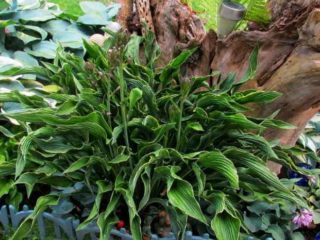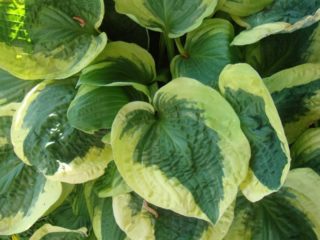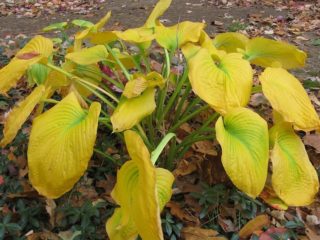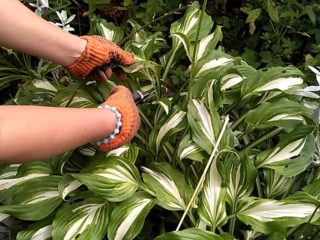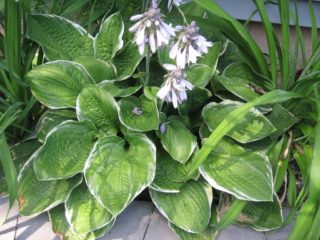Content
To decorate your garden plot, choose plants that are unpretentious and resistant to adverse conditions. Hosta White Feather combines these qualities and is distinguished by unique external properties. Therefore, this flower is popular among landscape designers and is often used for decorative purposes.
Description of White Feather Hosta
The plant was bred through selective breeding. Due to its low sensitivity to harmful factors, the White Feather hybrid hosta is considered the most effective variety.
White Feather bushes reach a height of 50 cm. The plant is spreading, so it requires space. The bush has several stems, each of which has many leaves. They are oval in shape with a slight point at the end.
Young leaves are creamy white. Later, as they grow, they become covered with bright green stripes.
At the beginning of summer, buds form on the White Feather bushes, on which flowers subsequently appear. On average, their size is 14-16 cm. The flowering period lasts from July to September, but can vary in regions with a specific climate.
The White Feather variety is shade-loving. It is not recommended to grow such hosta in well-lit areas for two reasons. Firstly, bright light causes the bush to look pale compared to other ornamental plants. Secondly, because of the sun's rays, White Feather hostas bloom worse.
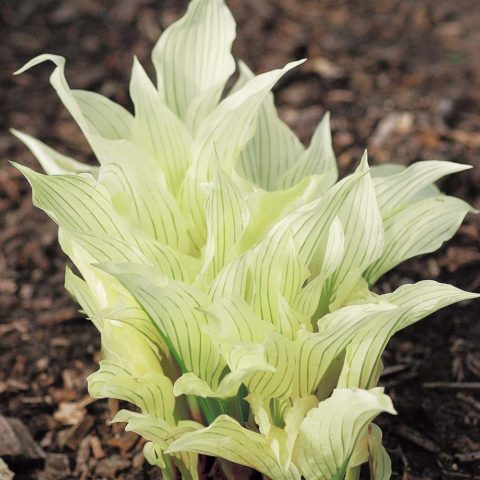
The White Feather variety is characterized by dense roots and the absence of a stem.
Otherwise, this plant is unpretentious, so caring for it is not accompanied by difficulties. Hosta tolerates low temperatures well in the winter season. As a decoration for a personal plot or garden, White Feather can be grown in regions with any climatic conditions.
Additional description:
Use of White Feather hosta in landscape design
The bush is used for landscaping. It is often grown as a background for bright flowers. The White Feather variety performs its decorative function in the shade. In shaded areas, the hosta combines harmoniously with many plants.
Among them:
- astilbe;
- peonies;
- ferns;
- lungworts;
- morning glory;
- Heuchera;
- phlox;
- primrose.
Hosta can be used as an independent decoration. They are also suitable for zoning a site as a low fence.

The hosta reaches its decorative value after 5 years.
It should be borne in mind that each White Feather bush needs space. They should not be planted close to each other. The optimal distance between them is 50 cm.
It is not recommended to plant hostas next to:
- roses;
- geranium;
- asters;
- coniferous shrubs;
- violets;
- eustomas.
Visually, hostas of the White Feather variety combine well with almost any plant.However, some of them should not be planted next to each other due to the fact that they are picky about the composition of the soil.
Hosta propagation methods White feathers
The main method is dividing the bush. It is necessary to choose a healthy, well-developed plant. They dig it up from all sides and take it out of the ground. Extraction from the soil is carried out with the utmost care so as not to cause serious damage to the roots. The bush should be divided using a sharp tool, after first clearing the underground shoots of the soil.
It is recommended to divide White Feather at the end of summer. In spring, reproduction should be abandoned. Otherwise, after planting in the ground, the plant will spend nutrients on the formation of buds, and not on root growth.
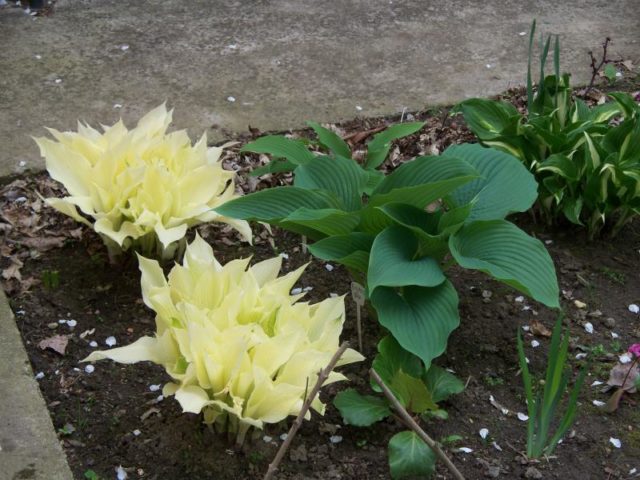
In a very dark place the bush will grow slowly
The White Feather flower can be propagated by seeds. They are collected after flowering and planted before winter. The disadvantage of this method is that the plant takes a long time to develop. The decorative effect of the bush is achieved only after 4-5 years.
Planting and caring for Hosta White Feather
First of all, you need to decide on the location. The White Feather variety is shade-loving, so you should not plant the bush in the sun. This hosta grows well in areas with any type of soil. The main thing is that the soil is loose enough and allows water to pass through well. Stagnation of liquid in the roots can provoke their rotting and death of the bush.
Planting is carried out in spring or autumn. The second option is recommended, since then the flower has time to adapt to the cold and tolerate the winter well.If you plant White Feather in the spring, the roots develop more slowly and the plant becomes sensitive to sudden changes in temperature.
Landing algorithm:
- In the selected area, dig a hole 35-40 cm deep.
- Place a layer of peat or compost on the bottom.
- Inside the hole, form a mound of cleaned garden soil.
- Place a seedling inside the mound so that there are no voids under the roots.
- Cover with loose soil on top.
- Water generously.
- Mulch the soil around the root collar with peat or humus.
The buds of the White Feather seedling should be located at ground level. If they are higher, roots will not develop from them. In this case, you need to sprinkle them with loose soil.
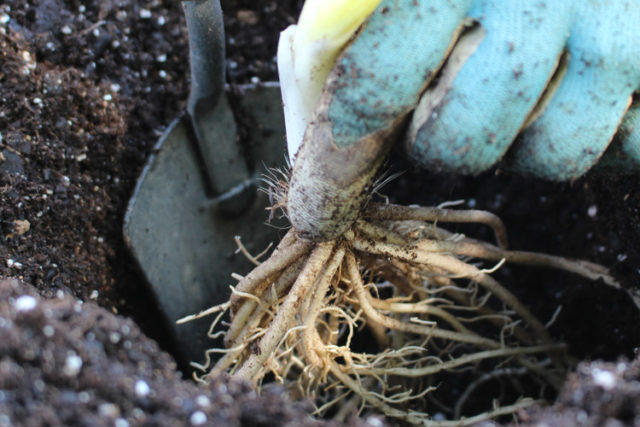
The host needs to be watered in a timely manner, destroy weeds and periodically add humus.
After planting in the soil, the plant needs to be watered every 3 days. The procedure is carried out 4-5 times, after which the volume of liquid is reduced.
Rules for growing white hosta White Feather
Despite its unpretentiousness, the bush will require care for its full development. In spring and summer, it is important to ensure that the soil is loose and moist. Around the bush you need to regularly remove weeds and plant debris.
Some leaves on the host may develop poorly or have a color uncharacteristic for the variety. They need to be removed in the early stages so that the bush does not waste nutrients on their growth.
From the description of Hosta White Feathers it follows that this plant loves moisture. In the warm season, watering is carried out 1-2 times a week. The frequency of watering is determined based on the amount of precipitation.
It is recommended to loosen the soil at least once a month.It is necessary to make the procedure more frequent if the weather was rainy. Due to precipitation, the soil becomes compacted, which prevents the normal functioning of the roots. When loosening, peat, tree bark and sawdust are added to the soil, which retain moisture in hot weather.
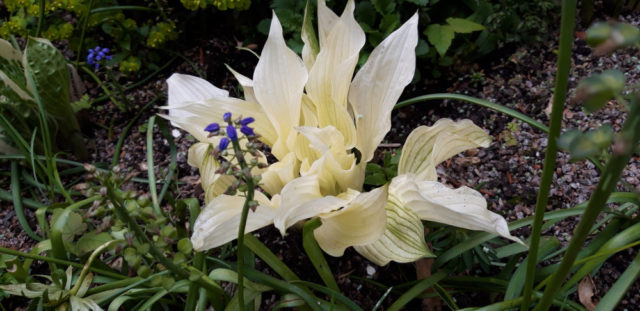
The perennial does not need to be fertilized for the first 4 years.
For hostas of the White Feather variety, both mineral and organic fertilizers are useful. During the growing season, liquid solutions with potassium and phosphorus should be used. It is recommended to add organic matter before flowering.
Hostas are best suited for:
- compost;
- a mixture of straw and manure;
- tree bark;
- humus.
Such fertilizers need to be applied under the soil around the bush. Organic matter should not be left on the surface, as it can attract pests.
Preparing for winter
The plant is resistant to low temperatures. Therefore, preparation for winter comes down to a minimum set of procedures.
In autumn, when flowering is over, the buds are cut off, leaving stems 6-8 cm long.
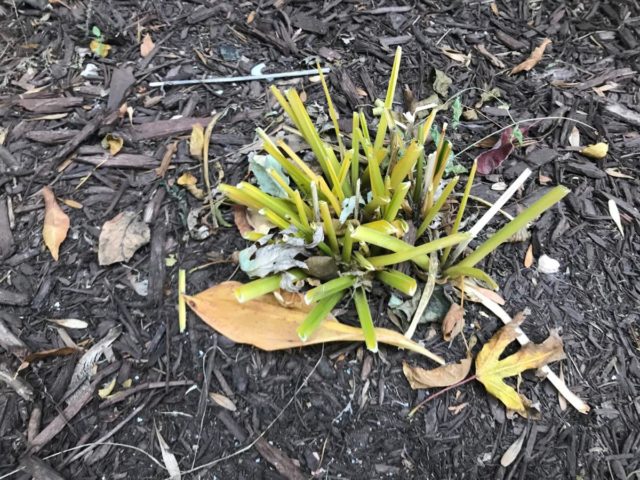
Hosta is very hardy and winter-hardy, so they do not need shelter.
Then you need to fertilize the bush with a potassium phosphate solution and treat it with a fungicide. The last feeding is carried out at the end of September. In the future, fertilizers are not applied so that the flower prepares for winter in a natural way.
To protect from freezing, the root part of the hosta is covered with soil. Sawdust, peat and straw are used as mulch. When persistent cold weather sets in, you need to cut off the stems with the remaining leaves.
The bush should be covered with coniferous branches. You can also use agril or breathable film. The bush cannot be covered with materials that do not allow oxygen to pass through, otherwise it will rot.
Diseases and pests
The White Feather hybrid is practically insensitive to infectious lesions.The exception is viral diseases that affect the condition of the leaves. The pathology is accompanied by the appearance of small yellow spots and dots. Affected sheets should be cut off and burned, and the instrument should be treated with a disinfectant.
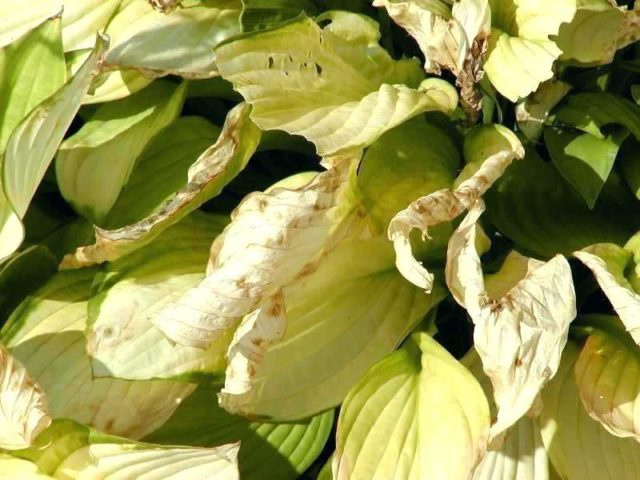
White Feather viral infections are transmitted not only through pests and pollen, but also through tools (secateurs)
Phyllostictosis may appear on mature plants. This is a fungal infection that causes brown spots to appear on the plant. Damaged areas are removed, and the White Feather bush itself is treated with a fungicide.
Young hostas may be attacked by pests. This usually happens due to improper care.
Common pests:
- leaf nematodes;
- aphids;
- slugs, snails.
To protect against parasites, it is recommended to sprinkle the soil around the shoots with tobacco ash and lime. As a preventative measure, you can mulch the soil with pine needles.
Conclusion
Hosta White Feather is a popular perennial used for decorative purposes. Due to its low sensitivity to harmful factors, such a bush can be grown by both experienced and novice gardeners. Hosta of this variety goes well with many plants. Therefore, with its help you can create unique flower arrangements and decorate your garden.
